翻译技巧一_词义选择
- 格式:ppt
- 大小:451.00 KB
- 文档页数:30
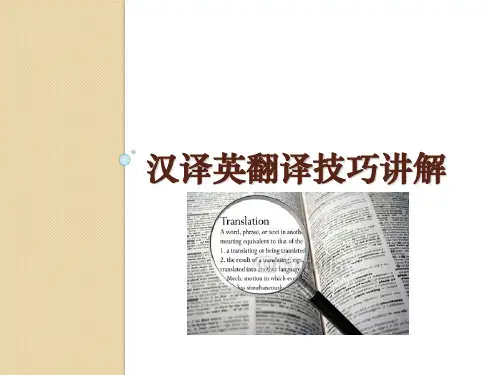

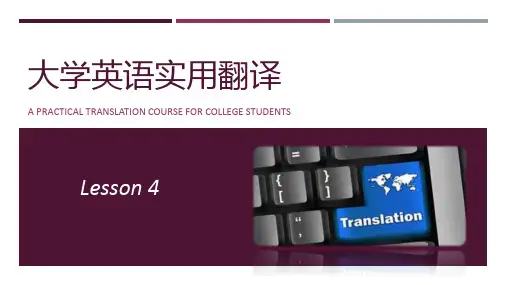
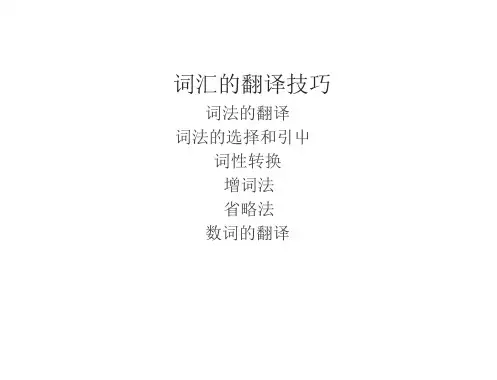
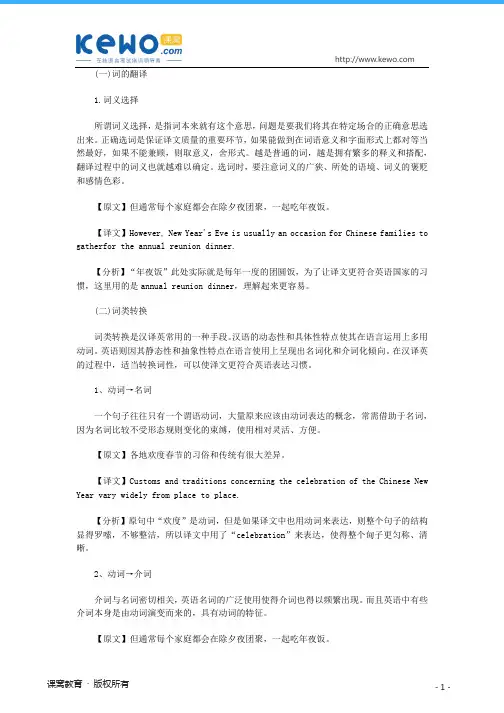
(一)词的翻译1.词义选择所谓词义选择,是指词本来就有这个意思,问题是要我们将其在特定场合的正确意思选出来。
正确选词是保证译文质量的重要环节,如果能做到在词语意义和字面形式上都对等当然最好,如果不能兼顾,则取意义,舍形式。
越是普通的词,越是拥有繁多的释义和搭配,翻译过程中的词义也就越难以确定。
选词时,要注意词义的广狭、所处的语境、词义的褒贬和感情色彩。
【原文】但通常每个家庭都会在除夕夜团聚,一起吃年夜饭。
【译文】However, New Year's Eve is usually an occasion for Chinese families to gatherfor the annual reunion dinner.【分析】“年夜饭”此处实际就是每年一度的团圆饭,为了让译文更符合英语国家的习惯,这里用的是annual reunion dinner,理解起来更容易。
(二)词类转换词类转换是汉译英常用的一种手段。
汉语的动态性和具体性特点使其在语言运用上多用动词。
英语则因其静态性和抽象性特点在语言使用上呈现出名词化和介词化倾向。
在汉译英的过程中,适当转换词性,可以使泽文更符合英语表达习惯。
1、动词→名词一个句子往往只有一个谓语动词,大量原来应该由动词表达的概念,常需借助于名词,因为名词比较不受形态规则变化的束缚,使用相对灵活、方便。
【原文】各地欢度春节的习俗和传统有很大差异。
【译文】Customs and traditions concerning the celebration of the Chinese New Year vary widely from place to place.【分析】原句中“欢度”是动词,但是如果译文中也用动词来表达,则整个句子的结构显得罗嗦,不够整洁,所以译文中用了“celebration”来表达,使得整个甸子更匀称、清晰。
2、动词→介词介词与名词密切相关,英语名词的广泛使用使得介词也得以频繁出现。
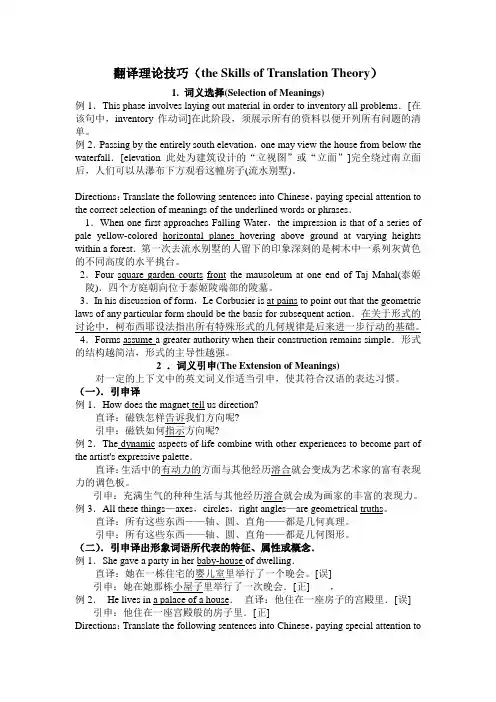
翻译理论技巧(the Skills of Translation Theory)1. 词义选择(Selection of Meanings)例1.This phase involves laying out material in order to inventory all problems.[在该句中,inventory作动词]在此阶段,须展示所有的资料以便开列所有问题的清单。
例2.Passing by the entirely south elevation,one may view the house from below the waterfall.[elevation此处为建筑设计的“立视图”或“立面”]完全绕过南立面后,人们可以从瀑布下方观看这幢房子(流水别墅)。
Directions:Translate the following sentences into Chinese,paying special attention to the correct selection of meanings of the underlined words or phrases.1.When one first approaches Falling Water,the impression is that of a series of pale yellow-colored horizontal planes hovering above ground at varying heights within a forest.第一次去流水别墅的人留下的印象深刻的是树木中一系列灰黄色的不同高度的水平挑台。
2.Four square garden courts front the mausoleum at one end of Taj Mahal(泰姬陵).四个方庭朝向位于泰姬陵端部的陵墓。
3.In his discussion of form,Le Corbusier is at pains to point out that the geometric laws of any particular form should be the basis for subsequent action.在关于形式的讨论中,柯布西耶设法指出所有特殊形式的几何规律是后来进一步行动的基础。

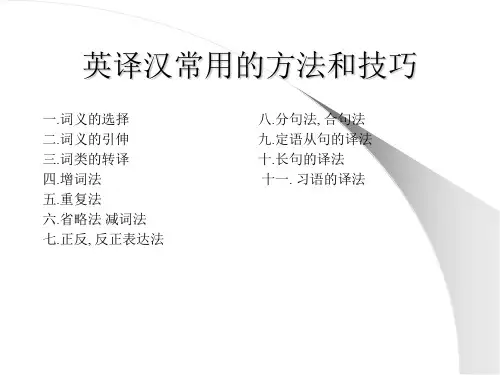
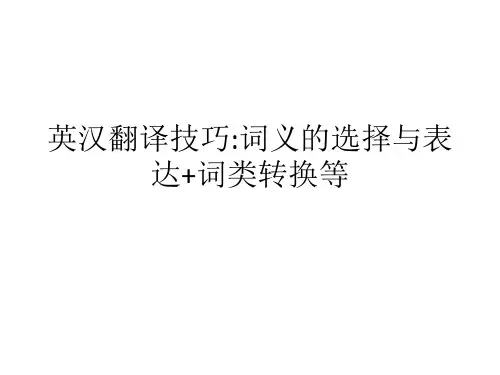
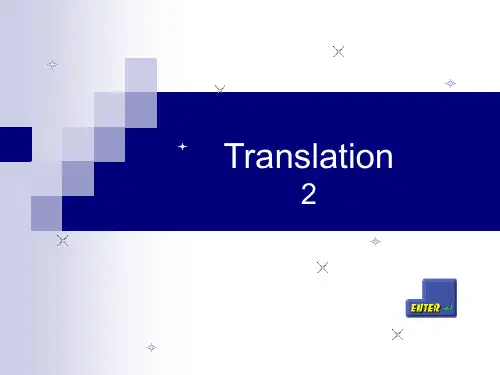

英语翻译技巧之词义选择词义的选择和词义引申是考研翻译中最常用的翻译技巧。
在考研翻译中,这中现象更是比比皆是。
在1994年72)题a leader of the new school contends中,school是“学派”的意思,而不是“学校”的意思;在1996年74)题elegant system中,elegant是“完美,完善”的意思,而不是“优雅”的意思;在2001年75)题And home appliances will become so smart that...中,smart是“智能化”的意思,而不是“聪明”的意思;在2003年75)题like the concept of set in mathematics中,set是“集,集合”而不是“一套,放置”等意思.......。
一、词义的选择如:I’ll see her home tonight.今晚我送她回家。
India is the home of elephants.印度是大象的生长地。
He’s at home with the classics.他精通古典文学New homes are for sale.新房出售。
She’s at home where she is.她在哪儿都自由自在。
Maternity home costs in America have gone up sharply.美国妇产医院收费已经急剧上涨。
Much is produced here for home market.这里为国内市场生产了许多产品。
He looks on London as his home.他把伦敦看成是他的故乡。
由此可见,一词多义的现象在英语中十分普遍。
在翻译时,词义的选择应从以下几个方面着手。
(一)根据词性确定词义如:forecast有“预报,预测”的意思,用作动词和用作名词时意思相同;increase 作动词时,表示“增加,增长,增进”的意思,用作名词时主要还是表达这些意思。
科技英语翻译技巧一——————词义的选择1.Packaged software is developed to serve the specific needs of one user.包装软件是根据用户的特殊需求来开发的。
2.Noises may develop in a worn engine.磨损的引擎可能产生噪音。
3.Shorts frequently develop when insulation is worn.隔热材料磨损时容易发生短路。
4.Sure enough, 80 percent of the plants developed the disease.果然,80%的植物遭遇了疾病的侵袭。
5.Other isolation methods are being developed.其他分离方法正在开发中。
6.In developing the design, we must consider the feasibility of processing.在进行设计的同时,我们必须考虑加工过程的可行性。
7.After the war much of this knowledge was poured into the developing of the computers.战后,很多这方面的知识被投入研制计算机。
8. A mathematical or logical operation must meet a certain condition.一个数学或逻辑运算必须满足一定的条件。
9.Interactive programming conditions are now available for some commercial programminglanguages.交互编程环境现在可以用于商用编程语言。
10.The results of a biopsy indicate a rare nonmalignant condition.活体检查的结果显示一个罕见的良性健康情况。
词汇翻译技巧一、词义的选择(Diction)1. 注意词的搭配汉语和英语两种语言在长期使用过程中形成了各自的固定词组和搭配,所以不能把汉语字词的搭配用法生搬硬套到英语译文中去。
汉、英两种语言的动宾搭配也有不同:例:学文化learn to read and write学知识acquire knowledge学外语study a foreign language学鸟叫imitate birds’ crying同样:发展经济develop our economy开发水资源develop the water resources冲洗胶卷develop a film展开说明develop an idea2. 根据上下文正确理解原文的词义有些汉语说法英译是按字面翻译,具体翻译时应视具体语境而定。
例1:有市场、有效益的速度,才是真正的发展,才是硬道理。
译文:Sound economic growth must be based on strong market demand and good economic returns. This is a .注意:“硬道理”也可根据我们中国文化的“异化”理解,翻译成:.例2:这种情况必须改变译文:This must change.分析:此处要正确理解原文的词义。
汉语措辞中的“情况”一词的基本意义与英语中的circumstance, situation, condition等词相近,但是究竟怎样翻译,还需要根据上下文来决定。
二、词的增补(Amplification)词的增补又常叫增译/增词法,是为使译文准确、通顺、达意。
增译有语义性增译修辞性增译,还有注释性增译(文内阐释或文中夹注)1.增补主语汉语中无主语的句子很多,汉译英时要根据上下文的意思选择适当的代词或名词补做主语。
增加什么主语取决于上下文。
例1:知己知彼,百战不殆译:2. 增补非人称的或强调句中的itit可以指天气、时间,还常用来表示强调、代替不定式等。